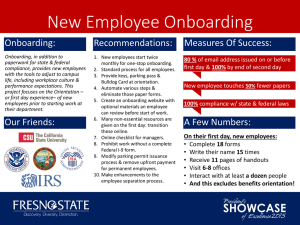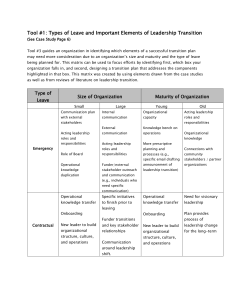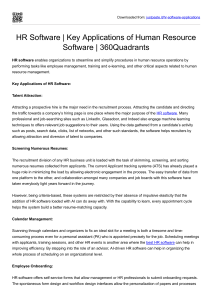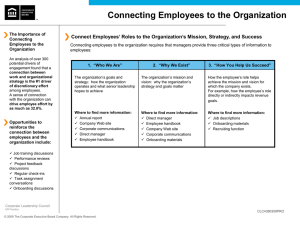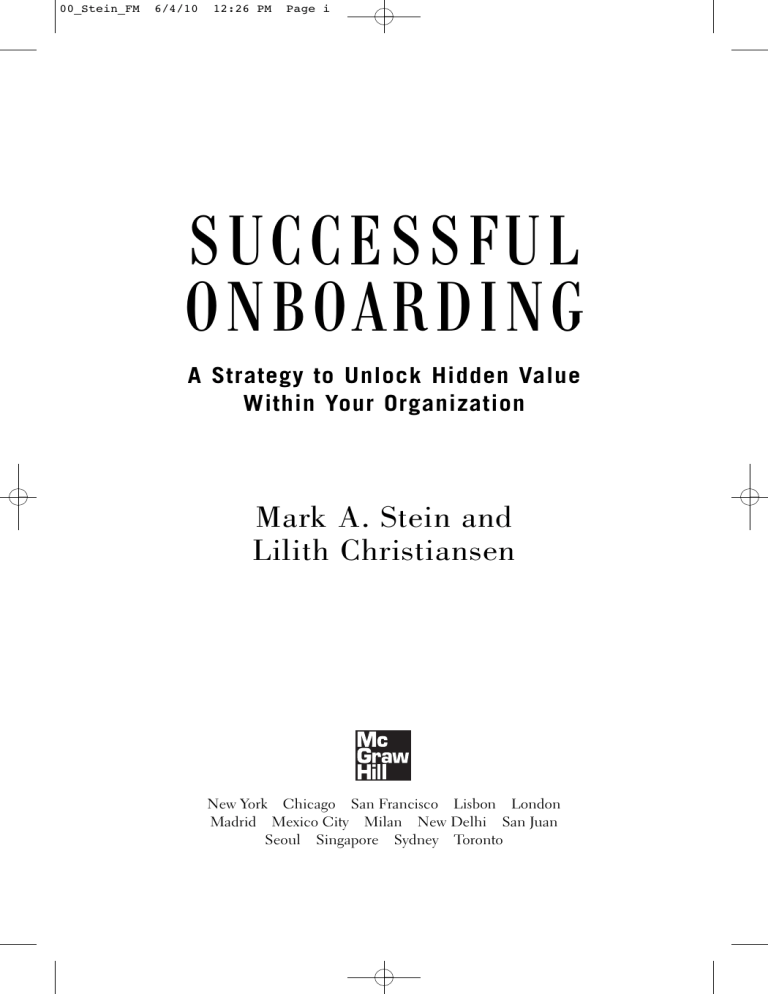
00_Stein_FM 6/4/10 12:26 PM Page i S UCC E S S FU L ON BOAR DI NG A Strategy to Unlock Hidden Value Within Your Organization Mark A. Stein and Lilith Christiansen New York Chicago San Francisco Lisbon London Madrid Mexico City Milan New Delhi San Juan Seoul Singapore Sydney Toronto 00_Stein_FM 6/4/10 12:26 PM Page ii Copyright © 2010 by Kaiser Associates, Inc., Mark A. Stein, and Lilith Christiansen. All rights reserved. Printed in the United States of America. Except as permitted under the United States Copyright Act of 1976, no part of this publication may be reproduced or distributed in any form or by any means, or stored in a database or retrieval system, without the prior written permission of the publisher. 1 2 3 4 5 6 7 8 9 10 DOC / DOC 1 9 8 7 6 5 4 3 2 1 0 ISBN 978-0-07-173937-5 MHID 0-07-173937-8 Onboarding Margin is a trademark of Kaiser Associates, Inc. McGraw-Hill books are available at special quantity discounts to use as premiums and sales promotions or for use in corporate training programs. To contact a representative, please e-mail us at bulksales@mcgraw-hill.com. This book is printed on acid-free paper. 00_Stein_FM 6/4/10 5:10 PM Page iii CONTENTS ACKNOWLEDGMENTS v INTRODUCTION 1 PART ONE RETHINKING ONBOARDING CHAPTER 1 THE BUSINESS CASE FOR ONBOARDING 17 CHAPTER 2 THE STATE OF THE ART: ESSENTIALS OF STRATEGIC ONBOARDING 51 APPENDIX: AN ECONOMIC ANALYSIS OF THE ONBOARDING MARGIN PART TWO THE NEW, NEW HIRE COMPACT CHAPTER 3 TEACHING CULTURE SO THAT OUR NEW HIRES “GET IT” 87 CHAPTER 4 “CONNECTIONS THAT COUNT”—EMPOWERING EMPLOYEES BY NURTURING VALUABLE RELATIONSHIPS 119 • iii • 00_Stein_FM 6/4/10 11:08 PM Page iv iv • Contents CHAPTER 5 PERSONAL PROGRESS AND PROSPECT: EARLY CAREER SUPPORT 143 CHAPTER 6 “LIMITED UPSIDE IN FLYING BLIND”: DRIVING STRATEGIC INSIGHT AND IMPACT 171 CHAPTER 7 THE ONBOARDING MARGIN LIFE SUPPORT SYSTEM: ADMINISTRATION AND GOVERNANCE 197 PART THREE THE ONBOARDING DESIGN PROCESS CHAPTER 8 GETTING STARTED: CONDUCTING A PROGRAM DIAGNOSTIC 225 CHAPTER 9 DRIVING IMPLEMENTATION—FROM BLUEPRINT TO IMPACT 243 CONCLUSION AND NEXT STEPS 265 ENDNOTES 267 INDEX 271 01_Stein 6/4/10 12:26 PM Page 1 INTRODUCTION How well would your company be doing if less than a third of new customers felt positive about their first year of interactions with your company? How would you feel if after six months a full third of your customers were seeking a new place to buy their products or services? Would your Senior Vice President of Manufacturing have a job today if a third of new manufacturing plants were not working (and he repeated this performance year after year)? At many companies, such outcomes would prompt a shareholder to call for new management. We believe that onboarding of new hires should meet the same, if not higher, standards. Over the past 10 years (and especially during the past five years), a number of Fortune 500 companies and small- to medium-sized businesses have reviewed traditional orientation programs and begun to embrace “onboarding” as a means of increasing employee productivity and engagement levels, reducing turnover, and elevating a company’s employment brand in the eyes of prospective hires. Yet despite millions spent on these initiatives, many firms have experienced a modest return on investment. Companies continue to absorb new hires less effectively than they otherwise might, and as a result they experience longer new hire time-to-productivity, higher attrition, frustrated hiring managers, and a mediocre return on investment. Consider these facts: • A full third of external hires are no longer with the organization after two years. • Less than a third of executives worldwide are positive about their onboarding experience. • Almost a third of executives who join organizations as an external hire miss expectations in the first two years. • Almost a third of employees employed in their current job for less than six months are already job searching.1 • 1 • 01_Stein 6/4/10 12:26 PM Page 2 2 • Successful Onboarding Companies need to take a serious look at how they are integrating new hires into the organization. Although onboarding has received attention in human resources circles, typical programs remain haphazard, limited in scope, and disconnected from a firm’s larger strategy. Onboarding usually amounts to little more than old and tired orientation programs—sometimes dressed up in new clothes. New hires are pulled through maybe a half-day of company introduction focused on corporate history, compliance policies, and employee benefits. They’re given basic job direction, introduced to a few peers and company leaders, and made aware of available training resources. They’re provided with security access and basic work tools (e.g., phone, computer, instruments, etc.). And that’s where the formal process ends. Firms offer little inspiration nor specific challenge, direction, or commitment to new hires. During the rest of the new hire’s first year—a make-or-break period in an employee’s tenure—firms leave it to overwhelmed and under-prepared hiring managers to address informally the critical needs that all new hires face, including help with job preparedness, development, assimilation, networking, and career planning. Senior leaders typically regard such activity as a mundane part of filling positions, not as a strategic opportunity to renew the company and its prospects. Most onboarding programs have other shortcomings as well. Companies will present the same orientation material to every new hire, irrespective of their level of career experience, defined role or responsibilities. In many cases, no single department oversees or retains accountability for the onboarding process. Therefore companies have little idea how successful the process is, and what metrics do exist are too broad and not tied to specific program goals. Administered by Human Resources, Recruiting, or Learning and Development, most programs do not possess buy-in from functional or business line management. Finally—and this is hardly an exhaustive account—most organizations do not keep themselves apprised of best practices, nor are they equipped to determine if and how to apply them. Onboarding programs, as a result, tend to remain static and unresponsive to newly adopted company strategy, marketplace changes, or new measures adopted by competitors. This book will help enterprises remedy these shortcomings—and realize a far bigger return—by introducing a strategic and systemic approach 01_Stein 6/4/10 12:26 PM Page 3 Introduction • 3 to onboarding, one that leading companies are already applying to great effect. Onboarding can and should be far more than a glorified orientation program, and in fact a number of progressive organizations have already begun to design and implement strategic programs that bring diverse stakeholders together to engage new hires over the first year plus of their tenure. These programs incorporate an array of content, including what we refer to as the four organizing pillars—early career support; orientation to the firm’s culture and its performance values; insight into the firm’s strategic position, intent, and direction; and activities and experiences that enable the new hire to build beneficial relationships. Strategic programs include important structural elements, including clear diagnostics and a system of feedback and accountability, and are customized for unique segments of new hires. They are also tightly integrated with the enterprise’s primary business and operating processes. On the most basic level, firms adopting strategic programs have begun to craft seamless first year experiences that, by taking seriously the perspective of new hires, hiring managers, and the enterprise in whole, address the ongoing needs of the business more effectively than ever before. Systemic programs have many benefits, not least that they can be more cost-effective than the disjointed programs commonly in place today. As we will demonstrate, strategic onboarding not only reduces operating costs, and helps new hires improve their personal contribution to the enterprise; it also reduces regrettable attrition, and helps the organization deliver against its strategic goals. The discipline can uncover immense new value—what we term the Onboarding MarginTM—even as it improves the enterprise’s employment brand in the eyes of employees and prospective recruits. Through real-world examples from our work with Chief People Officers, onboarding leaders at renowned universities, Fortune 500 HR executives, and other pioneers of the field, Successful Onboarding teaches the fundamentals and state-of-the-art practices that can improve the onboarding performance of any enterprise. Read on, and you’ll discover a framework for analyzing and understanding the opportunities available. You’ll also take your first step toward designing and implementing a best-in-class system for your own organization. 01_Stein 6/4/10 12:26 PM Page 4 4 • Successful Onboarding Broken Promises To understand how unhelpful standard onboarding experiences are, consider what happened to Charles Weber. After 13 years as a Learning and Development Leader with two large multinational corporations, Charles decided to pursue a leadership role with what he understood to be an upand-coming, high-growth company. Charles had grown frustrated by bureaucracy that had thwarted several human capital initiatives he’d spent years developing. At his last company, his promotion path was impeded by the firm’s L&D vice president, who seemed determined to stave off retirement as long as possible. It was time for a change. Charles spent months searching and interviewing for a new job, and he received several attractive offers. After many dinner table conversations weighing options with his wife (and contemplating the merits of his existing job), Charles accepted a role with a well-respected international financial services firm. Charles’ only reservation, the job’s slightly lower title and pay grade, was assuaged by a promise from his soon-to-be manager. “You’re our best candidate. Give me 6 months,” she promised with a wink and a nod. “I’ll make you a Director and you can be in charge of our Learning and Development programs. I just can’t bring you in as a Director.” Together, they crafted a set of responsibilities and an exciting initiative that Charles alone would design and lead. Charles enjoyed the early collaboration with his hiring manager and eagerly accepted the new position. The firm’s lead recruiter got word and was excited to have finally filled the position after 6 months of process and search. Things were looking good. What transpired next surprised Charles. After packing his family up, moving to a new home in a new city, and completing a week-long centralized orientation program, Charles arrived at his office eager to catch up with his new boss. Yet his boss’ office was empty. His boss, it turned out, had been conducting a personal job search, too. After waiting two weeks to meet with his boss’ replacement (an internal transfer), Charles discovered that the accelerated promotion timeline promised to him had not been communicated to anyone else in the company, nor was the new boss much enthused about taking up the political fight associated with an accelerated promotion. To make matters worse, Charles discovered that 01_Stein 6/4/10 12:26 PM Page 5 Introduction • 5 the specific initiative and associated responsibilities that sold him on the job belonged to another group within the company—and it was not going anywhere. In the blink of an eye, Charles’ excitement for his new role vanished. After weeks spent seeking a remediation path or support resources, Charles sat down at his new computer and restarted his job search. A month later, he was gone. Charles’ experience casts light on just a few of the common shortcomings of standard, non-strategic and non-systemic onboarding initiatives. Lacking any formal collaboration between recruiting, the hiring manager, senior management, and other parties in the firm—lacking, too, a process for addressing new hires’ career planning needs—Charles’ firm quickly wound up disappointing him. Even further, it broke “the hiring promise” it had made during the recruiting process. Charles in turn questioned his new company’s values and the support it would provide over the course of his career. Without anywhere to turn to figure out a solution, he could only conclude that a position with a smaller high-growth firm could be every bit as frustrating as his previous job with an established industry player. The best choice now was to leave. Charles was not the only one hurt by the lack of an adequate onboarding program; the company suffered, too. Charles was a supremely talented guy whom the firm had spent 6 months wining and dining and whom it had also engaged an external search firm to find (paying 20% of a year’s salary in a finder’s fee). Lost for good were the recruitment expenses, as well as the funds the firm had invested in his signing bonus, his moving expenses, and other administrative costs associated with his hire. In addition, the company had to spend even more money recruiting someone else to fill Charles’ position. Productivity suffered, since after six months of recruitment, two months of unenthused work on Charles’ part, and a subsequent search of undetermined length, the job position Charles was to have occupied would be filled by another person who would also likely require an adjustment period before being able to work at his or her best. Most damagingly of all were the long-term, indirect costs. When top-notch people like Charles become disillusioned, a firm’s brand becomes tarnished in the eyes of prospective employees (after all, Charles actively participates in online social networks), and it becomes even more difficult to attract the best talent. Also, the firm’s strategy suffers. How do you propel an organization 01_Stein 6/4/10 12:26 PM Page 6 6 • Successful Onboarding forward if you have a revolving door atmosphere, with key people leaving after short tenures and new people entering, bringing with them different skills, agendas, and commitments? Even if Charles had stayed, his hiring firm’s onboarding program would have failed to satisfy the organization’s needs. By limiting to a short program that merely familiarized new hires with the culture and helped them with some basic administrative tasks, Charles’ firm failed to acclimate new employees to their organization and its broader business goals. As a result, Charles would have been unable to connect his efforts with the firm’s strategy as creatively and proactively as he otherwise might. And if there were elements of the onboarding experience that caused Charles to get excited about a future at the company, there is a chance that Charles would have forgiven the company over his their initial entry snafus. Finally, by failing to explore with Charles over a sustained period how the organization defines success and how this could relate to the specifics of his own career, Charles’ firm was failing—by a long shot—to maximize its return on human capital. Strategic Onboarding: A Burning Need The sub-par performance of non-strategic onboarding programs seems especially troubling for firms when we consider the broader business context. Managers have long understood the financial and strategic challenges of integrating new talent. For decades, firms have wrestled with how to reduce time-to-productivity for new hires and increase retention. Yet today, it is not uncommon for organizations to battle 10 to 15% annual attrition, and they face the daunting prospect (or opportunity, depending on your perspective) of replacing over 50% of their employee base in a three- to five-year period. This phenomenon has received much attention in the business press. In 2008, in the midst of a weak economy and rising unemployment, BusinessWeek ran an article entitled “The Global Talent Crisis,” which cited “attracting and retaining talent” as one of the top threats to business success perceived by the over 850 C-level executives surveyed.2 “Competition” was the only threat that ranked higher. The broad trend facing hiring managers today is a dramatic increase in demand for high-potential recruits. Most large companies have highly 01_Stein 6/4/10 12:26 PM Page 7 Introduction • 7 tuned, albeit expensive, recruitment engines. Companies that recruited regionally now routinely conduct national searches with increased sophistication, support, and investment. Governments and non-profits are rethinking their recruitment and retention strategies given increased availability of top talent from the private sector. Although these organizations have increased access to A-level recruits, the focus must reside on retaining these new hires for the long term rather than risking high attrition. Of course, long-term social trends have made retention more difficult. Responding in large part to firms’ almost complete abandonment of pensions, young entering employees have shifted their attitudes toward prospective employers, with lifetime employment at a single firm becoming a stale and uninteresting concept. As we have all experienced, today’s younger workers have different—and in some ways, grander—expectations about employment. They seek meaningful careers, not merely wellpaying jobs. As a result, the best and the brightest give weight to the prospective employer’s employment brand, and more specifically to the company’s plan for them during their first year on the job and beyond. Even during hard economic times, these recruits are thinking beyond the first 30 days and focusing instead on what employers can do to address their long-term aspirations. To meet recruitment and retention challenges, leading firms are exploring how to redefine the employer-employee compact. To that end, they are pursuing state of the art onboarding programs even during recessions, when job markets are tighter. For some human capital teams, it’s a question of preparing for the inevitable economic upswing that will also incite a hiring uptick; a recession presents an opportunity to revamp and revitalize onboarding programs. Additionally, recessions produce a surplus of top talent, and companies that are selectively hiring want to ensure that they can retain these high achievers once bad times end. Beyond the challenges of recruitment and retention, productivity is perhaps the most important reason onboarding has taken on such immense strategic relevance for progressive firms. In today’s service-based and knowledge-based economy, new employee onboarding provides organizations with a critical means to retain the value and increase the productivity of one of their most important assets: human capital. And if done right, onboarding provides companies with the opportunity not only to 01_Stein 6/4/10 12:26 PM Page 8 8 • Successful Onboarding accelerate time-to-productivity of new hires, but also to elevate standards of productivity for all employees. The average organization replaces half of its employee base over a five- to 10-year period (because of 5 to 10% annual attrition). Imagine the impact if all of these new employees were better developed and prepared with a more comprehensive set of role expectations. Elevating new hire productivity levels through robust onboarding programs helps companies do more with less—a key business imperative in our dynamic, hyper-competitive 21st century economy. Elevating Onboarding … and Human Resources Despite the strategic importance of attracting, retaining, and maximizing the productivity of top talent, too many companies continue to neglect onboarding. Human Resources in general remains somewhat marginalized in the boardroom, all too often seen as a “soft” discipline. Some firms publically proclaim human resources a critical function only to limit the investment behind closed doors, treating human resources as a functional necessity rather than a true strategic value-add. This is a huge mistake; as our book argues, talent management and onboarding in particular should be on the radar of cross-functional managers as well as a firm’s senior leadership, up to and including the CEO. Many North American companies invest as much or more on new labor every year as they do in manufacturing infrastructure, yet management devotes far less time figuring out how to drive performance from this labor. This is true, even though, and probably because, it is actually far harder to engineer a positive outcome from human capital than from traditional capital investments. Management is simply more focused on areas that are perceived to be easier to tackle. Let’s look at the situation in another way. A 10% attrition rate means that, not even considering growth factors, your company will turn over nearly one third of its workforce in 31/3 years (i.e., 40 months)—a timeframe approximately in line with many firms’ product line refreshment, and also in line with average capital investments (with many assets having a 10-year life). Annual recruiting and intake has become the normal course of business, yet we don’t see company leadership recognize the fantastic strategic opportunity this investment represents, nor have they developed the management techniques to take advantage of it. 01_Stein 6/4/10 12:26 PM Page 9 Introduction • 9 We were once onboarding skeptics ourselves. We came to the discipline as business consultants whose Organization Development practice focused first and foremost on improving companies’ strategic and business performance—bottom line stuff. Earlier in the decade, one of our clients—a Fortune 50 company—asked us to help conceive a state-of-theart onboarding program. We were not all that familiar with the term “onboarding,” and the very concept seemed a bit lightweight and over the top to us. Early investigation on supposed best practices highlighted—as an example—attention to providing “white glove” service to new hires. As we saw it, our client was supposed to be hiring mature and responsible adults, people who were motivated to perform and who would be faced with all kinds of job requirements and standards. Why should the company spend money designing a sophisticated system to bring these employees into the organization? Shouldn’t a reasonably intelligent new hire be able to figure things out for him or herself? That’s what we—and most people that we knew—had done upon starting our own careers. We told our client that they were going down the wrong path. They should work harder on hiring better people rather than integrating new hires. In this, we took inspiration from Howard D. Schultz, Starbucks’ long-time leader, who has been reported by management guru Tom Peters to say, “We don’t train our people to smile, it is far easier for us to hire people who smile.” But it was not long before we changed our tune. Howard Schultz does not leave the customer experience to chance, nor does he leave the employee experience to chance. Instead, Starbucks and other leading companies apply “design thinking” to ensuring winning outcomes. Analyzing the process of integrating new hires as well as the needs that new hires brought to the table, we realized that onboarding was actually a tremendous business opportunity, even more exciting for being virtually unexplored by the large majority of firms. What most people associated with onboarding—the initial welcome and the initial orientation, getting new hires familiar and set up—turned out to be the least of the opportunities that a solid program could address. New hires will forgive you for not showing them where to park, or how to locate the supply rooms or the company’s history and mission statement; this we know from our research. But if they fail over the first year to discover enough that will excite and 01_Stein 6/4/10 12:26 PM Page 10 10 • Successful Onboarding enable them, that’s where you suffer your loss. Lost insight. Lost productivity. Lost ideas. Lost retention. In other words, lost profit and prospect. The more we probed into onboarding, the more we understood that this nascent discipline was actually, at its core, about business performance and the prospect for improving profit and profit potential. Our research into the state-of-the-art confirmed that most companies’ onboarding approaches were disconnected from the actual needs of new hires (their personal needs and their needs associated with their ability to deliver against the company’s aspirations). Also, these programs lacked buy-in from managers outside of human resources and unfolded over too short of a period to have any meaningful impact. If we could make our clients better at onboarding—if we could help them develop a program that was more comprehensive, systemic, and strategic than other firms’ programs—we could truly give them a sustainable competitive advantage (the Holy Grail for management consultants) that would affect their top and bottom lines. We’ve since engaged in more exhaustive best practice research, studying the operating conditions at firms such as Microsoft, Procter & Gamble, Deloitte Consulting, Target, Booz Allen Hamilton, Boston Scientific, Lockheed Martin, Verizon, FedEx Office, IBM, Best Buy, Ernst & Young, Deutsche Bank, and John Deere, among many others, including smaller firms. We’ve met with and collaborated with organizations in the public sector and diverse private industries and have addressed issues for both corporate knowledge workers as well as front-line employees. At each step, we’ve concerned ourselves with designing programs that support the companies’ human capital needs based on their strategic plan and operating environment. Findings from our broader organization development practice and our study of onboarding effectiveness have pushed us toward development of a strategic approach to onboarding. We learned early on that onboarding actually includes every experience that the new hire has in the course of the first year, not just the few that are owned and managed by centralized HR functions. It is this full set of experiences to which the new hire synthesizes and responds. Virtually all large and mediumsized organizations could benefit by creating onboarding programs that bring together stakeholders from across the enterprise, span at least the entire first year of the new hire’s tenure, provide a comprehensive, 01_Stein 6/4/10 12:26 PM Page 11 Introduction • 11 designed integration into the firm, and address both new hires’ diverse needs and the firm’s strategic goals. We’ve written Successful Onboarding to get the word out about strategic onboarding’s potential, and by extension, about that of the broader human resources discipline. We hope that senior leadership will support onboarding as a worthy initiative that really can create new value for their firms. Experience has shown that best outcomes occur when decision makers throughout a firm get excited by the value, buy into the program, participate in supporting the requisite systemic changes, and feel personally invested in the program itself. We therefore have sought to provide readers with information that can help drive successful discussions with important participants in the system. Additionally, we’ve written this book because we want every hiring manager in every organization to understand the onboarding process better, and because we want to raise awareness and know-how among HR leaders, many of whom still remain unfamiliar with strategic onboarding’s promise. There is a significant need for more clarity on this subject. As we’ve worked in our own practice to give onboarding more depth and rigor, we’ve encountered a great deal of confusion—a situation that’s gotten worse as more players have sought to jump on the onboarding bandwagon. Over the last few years, a number of vendors have developed valuable off-theshelf software for use by human resources professionals. But this software as implemented usually serves merely to automate the administration of orientation activities. Given the wide promotion and availability of this software, managers interested in learning about onboarding often develop a limited impression of the subject as a result of the information they find when they Google the topic. One software vendor’s web site, for instance, defines onboarding as a process that involves the following exchanges with a new hire: Hiring Documents, Employee Handbook, Drug Screen, Relocation, Computer, Network Access, Workstation Setup, ID Badge, Security Access, Parking Permits, Business Cards, Expense Account—all “first-day” activities. Then the vendor talks about attrition activities: Security Deactivation, Asset Recover, and Exit Interview—“last day” activities. It’s ironic (or tragically comical) that this model completely ignores all of the important elements—the things in between the first and last day of employment. And 01_Stein 6/4/10 12:26 PM Page 12 12 • Successful Onboarding this example, although a bit extreme, is truly representative of the sentiment associated with most solutions and published material in the public domain. To many people, onboarding seems to involve nothing more than handing tools out and then collecting them back during an “off-boarding” phase. You can imagine our frustration. A number of human capital and business magazines have covered onboarding and reported on “best practices,” but they typically fail to distinguish between a progressive practice and proven best practices, and they also fail to explore the operating conditions that define which practices should apply when. As a result, many managers have adopted practices that give the firm a sense of being “progressive,” but that lack the requisite rigor to make them impactful. The result, sadly, is a modest to negative return on investment. We’ve designed this book to give readers at any level of an enterprise the understanding they need to take advantage of onboarding’s strategic and financial opportunities. Even when firms recognize their existing programs’ shortcomings, their redesign efforts often come up severely short; in framing the new hire’s experience, companies tend to over-emphasize the fun, the welcome, and the service side of things, often presenting an unrealistic sense of what the firm is all about and setting unsustainable expectations. Additionally, companies tend to apply insufficient diagnostic and design techniques and pay insufficient consideration to what is required to govern, update, and sustain onboarding programs over time. As a result, many efforts enjoy a great first release before losing energy, leading to decreasing returns. Human resources professionals need a deeper understanding of how to design human capital programs that cut across functional silos to create value. This book provides that understanding by describing the fundamentals of robust, year-long onboarding programs. Chapter 1 presents the business case for onboarding, while Chapter 2 presents the general characteristics of a world-class, strategic program. Chapters 3 through 7 explore the contents and administrative features of strategic programs in considerable detail. Presenting examples and anecdotes from our practice, we describe the best-in-class principles firms are now using to help meet the pressing needs efficiently and effectively. The final two chapters focus on how to develop a strategic onboarding program. We discuss elements of 01_Stein 6/4/10 12:26 PM Page 13 Introduction • 13 diagnostic, planning, implementation, and ongoing operations, and conclude the book with an extended case study of a successful onboarding program’s design and implementation. Rethinking the Metaphor Before embarking on our journey through state-of-the-art onboarding, let’s reflect for a moment on this term itself. “Onboarding” is a metaphor, and a rather obvious one at that; it evokes a process for bringing a person onto a ship. The staff of a cruise ship, for example, would “onboard” a ship’s guests by getting all of the luggage to the correct cabins, conducting a safety drill, showing them around (dining room, casino, movie theater, etc.), and describing what activities they might enjoy so that they feel welcome and familiar. This book argues that we need to redefine this metaphor if we are to have any hope of unlocking the potential of this important process. As talent managers, we’re not welcoming visitors to a company; we are employing and deploying employees or human capital investments—people that we should expect to stay and make a difference. We need to go beyond the superficial and take care to teach new hires things vital to the organization’s successful performance—how to steer the ship, what makes it go, the ship’s and the cruise line’s business model and competitive environment, the intricacies of how one department works with another to create a good customer experience, the long-term goals of the ship. The only way a guest can get off a cruise early is to jump ship, and we don’t want our employees to do that. Rather, we want them to make a big contribution. Thus we need to do more. Strategic onboarding is a process by which a workforce is reconstituted and enrolled to align with a firm’s primary emerging business strategy. From a new hire’s perspective, onboarding encompasses everything a new hire experiences that defines his or her entry and orientation into an organization and that sets him or her up for success. From an organizational perspective, it’s the experiences and programs that can be designed to set up employees as well as meet the needs of the new hire manager to have staff become productive quickly. If you embrace strategic onboarding, your enterprise won’t see as many new hires frustrated by a boss who knows 01_Stein 6/4/10 12:26 PM Page 14 14 • Successful Onboarding little about what the recruiters have suggested about career advancement (nor will you have recruiters making promises that may not be delivered). Your firm won’t have new hires struggling to introduce themselves to managers and other people critical to their career. Your firm won’t have highpotential recruits disillusioned because they’ve waited too many weeks to get their first assignment. Instead, your firm will have motivated, inspired employees who adjust quickly, remain enthusiastic, and are empowered to contribute at levels not usually delivered—giving you a competitive advantage that can produce top- and bottom-line results. What could be more desirable and worthy than this? 00_Stein_FM 6/4/10 10:44 PM Page a Praise for Successful Onboarding In Successful Onboarding, Lilith and Mark demonstrate the financial impact that the onboarding process can have on your organization and provide a road map for improving your return on investment. The book has already changed the way we think about onboarding in our organization. —Andrew Blocher, Chief Financial Officer, Federal Realty Investment Trust This book has the potential to change the way we think about new hires and what is possible from this group. With the instruction provided, you can migrate onboarding from the administrative to the strategic, and deliver far greater value for your enterprise. —Betty Thompson, Senior Vice President, People Services, Booz Allen Hamilton This is an important book for business leaders who want to assure employee engagement from day one! Practical and instructive, the book gives leaders everything required to plan and implement an onboarding strategy that provides maximum organizational benefits. Not only does the book convincingly build the business case for excellence in onboarding, the authors lay out in the clearest of terms a recipe to assist practitioners to plan and implement a strategy that will contribute the results we are all looking for—engaged employees who choose to build a career in our organizations and contribute to organizational success in the long term! Well done! —Bonnie DuPont, Corporate Director and former Group Vice President, Corporate Resources, Enbridge, Inc. An approach to transforming your organization’s onboarding process from a onetime transaction to a sustained and integrated employee experience that drives performance and engagement right out of the gate. —Matt Motzkin, Director, Organizational Development, Disney-ABC Television Group A comprehensive and highly practical guide to the critical—but underappreciated—practice of onboarding new employees. The authors make a convincing business case for strategic onboarding and then outline a step-by-step process for a positive and enduring outcome. —Max Stier, President and CEO, Partnership for Public Service 00_Stein_FM 6/4/10 10:44 PM Page b Successful Onboarding could easily be titled Maximizing Your ROI. If you adopt the authors’ perspective and follow the best practices they present, your organization will get the greatest possible return on its investment in new talent. Stein and Christiansen’s work will shift your focus from activities to results. —Scott Eblin, Executive Coach; author, The Next Level: What Insiders Know About Executive Success This is a terrific resource for anyone wanting to create an effective onboarding program. —Mindy Moye, Ph.D., Manager, Employee Engagement, John Deere Every company leader who is serious about delivering results through people should read this book. Successful Onboarding not only gives a roadmap to successful hiring and retention but also addresses the common pitfalls that lead to adjustment struggles, discouragement, and skepticism from new hires. This book rings true to those of us who coach leaders in the onboarding transition. —Kate Ebner, Co-Director, Georgetown University Leadership Coaching Program; Principal, The Nebo Company People are a company’s most important asset. Successful Onboarding makes the case for the importance of effective onboarding in setting up employees for success. —Stephen Squeri, Group President, Global Services, and Chief Information Officer, American Express Company Goodbye old school orientation and hello to onboarding. A great reference to tailor your onboarding based on your culture and strategy. This book demonstrates how sound and creative onboarding can prevent a lot of voluntary off-boarding from high performing employees. —Sonia Narang, Director, Leadership and Organization Development, Sony Pictures Entertainment Hiring employees is the biggest investment most organizations make. Understanding how to make sure that investment sticks is what onboarding is about, and Successful Onboarding shows you how to do it right. —Peter Cappelli, Director, Center for Human Resources, The Wharton School, The University of Pennsylvania; author, Talent on Demand
